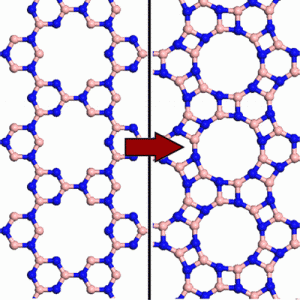Perim Martins, Eric; Paupitz, Ricardo; Autreto, Pedro Alves da Silva; Galvao, Douglas Soares
Inorganic Graphenylene: A Porous Two-Dimensional Material with Tunable Band Gap Journal Article
Em: The Journal of Physical Chemistry C, vol. 118, não 41, pp. 23670–23674, 2014.
@article{perim2014inorganic,
title = {Inorganic Graphenylene: A Porous Two-Dimensional Material with Tunable Band Gap},
author = {Perim Martins, Eric and Paupitz, Ricardo and Autreto, Pedro Alves da Silva and Galvao, Douglas Soares},
url = {http://pubs.acs.org/doi/abs/10.1021/jp502119y},
year = {2014},
date = {2014-01-01},
journal = {The Journal of Physical Chemistry C},
volume = {118},
number = {41},
pages = {23670–23674},
publisher = {American Chemical Society},
abstract = {By means of ab initio calculations, we investigate the possibility of existence of a boron nitride (BN) porous two-dimensional nanosheet, which is geometrically similar to the carbon allotrope known as biphenylene carbon. The proposed structure, which we called inorganic graphenylene (IGP), is formed spontaneously after selective dehydrogenation of the porous boron nitride (BN) structure proposed by Ding et al. We study the structural and electronic properties of both porous BN and IGP, and it is shown that, by selective substitution of B and N atoms with carbon atoms in these structures, the band gap can be significantly reduced, changing their behavior from insulators to semiconductors, thus opening the possibility of band gap engineering for this class of two-dimensional materials.},
keywords = {},
pubstate = {published},
tppubtype = {article}
}
Bruno I. Santos Gustavo Brunetto, Pedro A. Autreto; Galvao, Douglas S.
A Nonzero Gap Two-Dimensional Carbon Allotrope from Porous Graphene Conferência
A Nonzero Gap Two-Dimensional Carbon Allotrope from Porous Graphene, não AA15.102, MRS, 2011.
@conference{2011MRSFall,
title = {A Nonzero Gap Two-Dimensional Carbon Allotrope from Porous Graphene},
author = {Gustavo Brunetto, Bruno I. Santos, Pedro A. Autreto, Leonardo D. Machado, R. dos Santos and Douglas S. Galvao},
url = {http://www.mrs.org/f11-abstracts-aa/
https://sites.ifi.unicamp.br/autretos/files/2015/04/2011MRSFallMeeting-AA-Abstracts-Symposium-AA-Carbon-Nanotubes-Graphene-and-Related-Nanostructures..2011-MRS-Fall-Meeting.pdf},
year = {2011},
date = {2011-12-02},
booktitle = {A Nonzero Gap Two-Dimensional Carbon Allotrope from Porous Graphene},
number = {AA15.102},
publisher = {MRS},
abstract = {In the last decades many new carbon-based materials have been discovered. Examples of these materials are fullerenes, carbon nanotubes and graphene. Graphene has been one of the hottest topics in materials science in the last years. Graphene is a two dimensional array of hexagonal units of sp2 bonded carbon atoms with very unusual and interesting electronic and mechanical properties. Because of its special electronic properties, graphene is considered one of the most promising materials for future electronics. However, in its pristine state graphene is a gapless semiconductor, which poses some limitations to its use in some transistor electronics. Many approaches have been tried to create, in a controlled way, a gap in graphene. Among these approaches we can mention oxidation and chemical functionalizations. Hydrogenated graphene-like structures have been recently synthesized, as the so-called porous graphene [1]. In this work we show, based on ab initio quantum molecular dynamics calculations, that porous graphene dehydrogenation can lead to a spontaneous formation of a nonzero gap two-dimensional carbon allotrope, called biphenylene carbon (BC). This structure presents the ideal properties to electronic applications. Besides exhibiting an intrinsic nonzero gap, BC also presents well delocalized frontier orbitals, suggestive of a structure with high electronic mobility. Possible synthetic routes to obtain BC are addressed. [1] Y. F. Li, Z. Zhou, P. W. Shen, and Z. F. Chen, Chem. Commun. v46, 3672 (2010).},
keywords = {},
pubstate = {published},
tppubtype = {conference}
}
2014

Perim Martins, Eric; Paupitz, Ricardo; Autreto, Pedro Alves da Silva; Galvao, Douglas Soares
Inorganic Graphenylene: A Porous Two-Dimensional Material with Tunable Band Gap Journal Article
Em: The Journal of Physical Chemistry C, vol. 118, não 41, pp. 23670–23674, 2014.
Resumo | Links | BibTeX | Tags: boron nitride, molecular dynamics, porous graphene
@article{perim2014inorganic,
title = {Inorganic Graphenylene: A Porous Two-Dimensional Material with Tunable Band Gap},
author = {Perim Martins, Eric and Paupitz, Ricardo and Autreto, Pedro Alves da Silva and Galvao, Douglas Soares},
url = {http://pubs.acs.org/doi/abs/10.1021/jp502119y},
year = {2014},
date = {2014-01-01},
journal = {The Journal of Physical Chemistry C},
volume = {118},
number = {41},
pages = {23670–23674},
publisher = {American Chemical Society},
abstract = {By means of ab initio calculations, we investigate the possibility of existence of a boron nitride (BN) porous two-dimensional nanosheet, which is geometrically similar to the carbon allotrope known as biphenylene carbon. The proposed structure, which we called inorganic graphenylene (IGP), is formed spontaneously after selective dehydrogenation of the porous boron nitride (BN) structure proposed by Ding et al. We study the structural and electronic properties of both porous BN and IGP, and it is shown that, by selective substitution of B and N atoms with carbon atoms in these structures, the band gap can be significantly reduced, changing their behavior from insulators to semiconductors, thus opening the possibility of band gap engineering for this class of two-dimensional materials.},
keywords = {boron nitride, molecular dynamics, porous graphene},
pubstate = {published},
tppubtype = {article}
}


